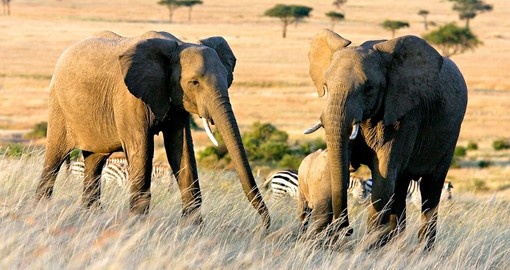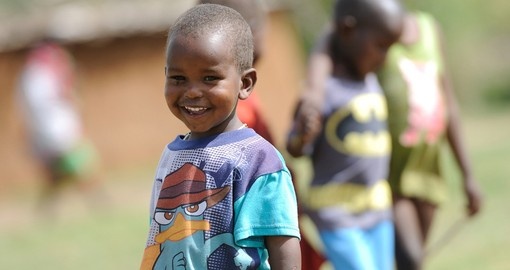Kenya Tourist Attractions
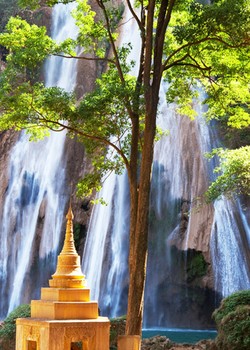 THE ABERDARES
THE ABERDARES
THE ABERDARES are a beautiful mountain range in the central highlands of Kenya, for the most part, over 3000m (10, 000ft) in altitude. Within the heart of these mountains is the Aberdares National Park, a magical place of dense forest, and misty moorlands, where icy rivers plunge in glorious cascades and waterfalls. This area is rich in wildlife. Among a variety of mammals more commonly seen are elephants, buffalo, rhino, forest-hog, colobus, and Sykes monkeys, and a wide variety of antelope including the legendary and rare bongo. Birdlife is abundant and varied. 200 species have been recorded, perhaps the most conspicuous group of which are the sunbirds. Birds of prey such as the crowned eagle, mountain buzzard, and African goshawk are of special interest. A game viewing drive, possibly en route to Treetops or the Ark, is essential here.
ABERDARE COUNTRY CLUB - A romantic, quiet, and relaxing getaway with a game sanctuary. Guests stay in cozy grey stone cottages nestling among lush gardens.
THE ARK - An architectural masterpiece standing high above the ground in a secluded forest glade where wildlife viewing takes place at close range. Not recommended for children.
TREETOPS - Overlooking water holes and a salt lick, this is a functional lookout lodge solely dedicated to game viewing at close range.
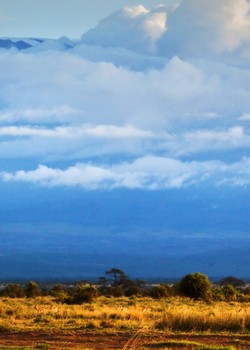 AMBOSELI NATIONAL PARK
AMBOSELI NATIONAL PARK
AMBOSELI NATIONAL PARK lies below the most famous symbol of Africa - Mount Kilimanjaro 5, 895m (19, 340 ft) the highest mountain in Africa and the tallest free-standing mountain in the world. The surrounding area is flat, covered by savannah and acacia scrub and the animals stand in silhouette against the giant mountain, its snow-clad peak floating in the stark blue African sky. A large part of the park consists of the alluvial dried-up bed of the seasonal Lake Amboseli, which in the rainy season can transform into a shallow flood while the dry season brings strange mirages above the lake's dry shimmering surface.
Towards the centre of the park is a series of swamps, fed by the underground rivers running off the mountain. It is here, closer to the water, that the concentration of wildlife intensifies, from the ever-present ponderous herds of elephants to abundant birdlife. This includes a wide variety of waterbirds such as grey heron, saddle bill stork, Egyptian goose as well as long-toed lapwing., yellow-throated sand grouse, and up to six species of vulture. The rare Madagascar Squacco Heron is a frequent visitor. Other games frequently seen include buffalo, zebra, wildebeest, gazelle, Maasai giraffe, and if you look carefully in the grass, the occasional lion and cheetah.
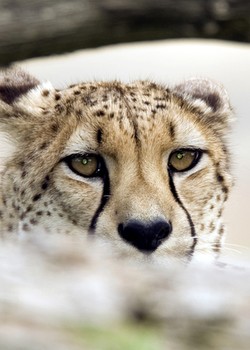 MASAI MARA NATIONAL RESERVE
MASAI MARA NATIONAL RESERVE
MAASAI MARA NATIONAL RESERVE is situated to the west of Nairobi, on Tanzania's northern border. This 1,812 km² (700 sq. miles) Reserve is the northern extension of the larger Serengeti National Park - a massive 56,000 km² (5,600 sq. miles).
The Masai Mara offers wonderful scenery and an abundance of big games. It is perhaps the only region left in Kenya where the visitor may see animals in the same super-abundance that existed a century ago. It is a reserve of breathtaking vistas, panoramas of vast rolling plains, hills, and woodland groves, well watered by the lovely Mara River which bisects the Reserve from north to south.
The Mara is home to the largest population of lions in Kenya. These magnificent beasts spend most of the day sleeping in the shade of acacia trees. Vast herds of buffalo, zebra, and wildebeest roam the plains. Impala, gazelle, giraffe, and hartebeest grace the landscape. The cautious topi may also be seen standing sentinel on earth mounds on a constant look-out for predators. The waters of the Mara River are home to crocodiles and pools of hippo, the acacia woodlands and riverine forests favored by leopard and elephant, and the open savannah and dry bush areas host the plains game and their attendant predators such as lion, cheetah, hyena, and jackal.
The birdlife of the Mara is as profuse as the animal life. On the open plains, there is a variety of bustards and ground hornbills. Birds of prey are abundant - no less than 53 species have been recorded, including the magnificent Bateleur eagle. In the sky, there are always opportunistic vultures circling and waiting in anticipation, and distinctive secretary birds are a common sight as they stalk sedately over the open plains.
WILDEBEEST MIGRATION
The wildebeest migration takes place within Kenya and Tanzania and is one of the greatest wildlife shows on earth. Between the open plains of the Serengeti and the Masai Mara, thousands of wildebeest and zebras migrate to greener pastures as the seasons change. The precise timing of the Wildebeest Migration changes annually. The calving season takes place in the Serengeti between the months of January and mid-March before the Wildebeest Migration begins, heading towards the Western Serengeti in June. The best time to see the migration is usually between June and August when the wildebeest congregate and prepare to cross the famous Grumeti River. If you are in the Masai Mara you can expect the wildebeest to arrive as early as July, but they generally arrive between August and September and remain in the Mara between October and November. Between December and January, the wildebeest gradually begin their migration back towards the Serengeti. These monthly migration patterns can change from year to year, so these estimates should be used as a general guide.
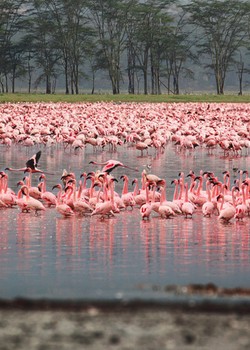 LAKE NAKURU NATIONAL PARK
LAKE NAKURU NATIONAL PARK
Situated between Lakes Naivasha and Baringo, beneath the high cliffs of the Eastern Rift, lies Lake Nakuru. This is a shallow soda lake surrounded by yellow-barked acacia woodland and grasslands, rocky cliffs, and hillsides covered with the unusual giant Euphorbia trees.
Lake Nakuru is world famous as home to flocks of greater and lesser flamingoes, which frequently form a stunning pink ribbon along the edges of the lake. But flamingoes are unpredictable and are not always found here in such vast numbers. They migrate up and down the Rift Valley from Natron to Turkana in search of the best food supply, and their numbers at Lake Nakuru have declined in recent years. However, other species still populate the area in healthy numbers. An entertaining spectacle is the large flocks of pelicans found fishing and washing at the southern end of the Lake. Over 400 species of birdlife have been recorded at the lake, making this yet another of Kenya's major ornithological sites.
In addition to the birdlife, the park is home to herds of buffalo, waterbuck, impala, Rothschild giraffe, and leopard. A defined area of the park has now been designated a rhino sanctuary, making it one of the best places in Kenya to see rare black rhino.
KIGIO WILDLIFE CONSERVANCY
Kigio Wildlife Conservancy is a noteworthy 3,500-acre conservancy between Nakuru and Naivasha in Kenya. The beautiful conservancy with its wide-ranging habitats, from riverine and euphorbia woodlands to short grass and Leleshwa shrub, holds approximately 3,500 heads of wildlife (including the endangered white rhino and Rothschild giraffe, a 200-strong herd of buffalo, impala, Grants and Thomson's gazelle, eland, hyena, leopard, hippo, and over 200 bird species) which are protected by an electric fence on three sides and the Malewa River on one.
The Conservancy's rich bio-diversity has been recognized internationally by Tusk Trust, Born Free Trust, Lewa Wildlife Conservancy, and several private donors who have provided funds to improve the infrastructure in the conservancy and to help wildlife conservation and surrounding communities. The Conservancy is at the forefront of Eco-tourism in the Rift Valley lakes area.
SAMBURU & BUFFALO SPRINGS NATIONAL RESERVES
Rugged and remote, these wildlife reserves lie within the fascinating semi-desert area of Kenya's Northern Frontier District.
The Samburu National Reserve - a lava plain with steep-sided gullies and rounded hills - is physically dramatic with the great Ololokwe table mountain in the background. The central feature of the reserve is the winding and looping Ewaso Nyiro river. On either side of the river, a green ribbon presents a gallery of forest acacia, doum palm, and Tamarind, which act as hosts to a multitude of birdlife. Some of Kenya's rarer species like the long-necked gerenuk, Grevy's zebra, reticulated giraffe, beisa oryx, and blue-shanked Somali ostrich can be seen here.
The Buffalo Springs Reserve connects to Samburu in the south and is more or less an extension of the same kind of environment. However, as the name implies, the major source of relief in this reserve is an outflow of clear spring water which attracts migrant game and predators from miles around. This reserve is bounded in the north by the Ewaso Nyiro which doesn't reach the sea but meets the Lorien Swamp to the east.
THE GLORIOUS COAST
Kenya is lined with white sandy beaches - fringed with palms, casuarinas, bright bougainvillea, mangrove swamps, and magical creeks, all washed by the turquoise waters of the Indian Ocean. The air is scented with the sweetness of frangipani and refreshed by gentle monsoon breezes. Gazing calmly out across magical coral reefs to the open sea, this is one of the most idyllic resort areas in the world. Most come to enjoy the simple pleasures of this sun, sand, and water wonderland. For those inclined to snorkel or scuba dive, Kenya's reefs, coral gardens, and lagoons rival the world's most beautiful.
For much of its length, from Malindi in the north to Vanga in the south, the shore is protected by the fascinating coral reef. Inside this protected environment in sheltered lagoons grow magical marine plants and other creatures and contains over 250 brilliantly coloured species of fish. National marine parks off Watamu, Malindi, Mombasa, and Shimoni protect these reefs and the waters they embrace.
Mombasa is the old and colourful gateway to Kenya and is a vibrant mixture of the ancient and modern, with an interesting blend of African, Arab, and Asian cultures. This beautiful port, evocative of the east, is actually an island. Fringing the dhow harbour is the old town, a maze of narrow streets, quaint shuttered houses, and open-fronted shops. The ancient Portuguese 'Fort Jesus' still stands sentinel - now a fine museum of antiques. The experience of Mombasa somehow isn't quite complete without a trip aboard the exclusive Tamarind Dhow.
Kenya Travel Information
At Goway we believe that a well-informed traveller is a safer traveller. With this in mind, we have compiled an easy-to-navigate travel information section dedicated to Kenya.
Learn about the history and culture of Kenya, the must-try food and drink, and what to pack in your suitcase. Read about Kenya's nature and wildlife, weather, and geography, along with 'Country Quickfacts' compiled by our travel experts. Our globetrotting tips, as well as our visa and health information, will help ensure you're properly prepared for a safe and enjoyable trip. The only way you could possibly learn more is by embarking on your journey and discovering Kenya for yourself. Start exploring… book one of our Kenya safaris today!
Extend Your Trip
After your African Safari, why not consider one of Goway's Europe tours or Egypt tours en route from Kenya or perhaps a stopover in Dubai on one of our United Arab Emirates tours
Book your Kenya vacation with Goway!
 AfricaExperts is the exclusive division of Goway that specializes in planning and organizing Kenya safaris and experiences. Choose from a locally escorted tour, an exclusive African game lodge, a stay of distinction, a small group tour, and more. We want to be your first choice when next you go globetrotting to Kenya.
AfricaExperts is the exclusive division of Goway that specializes in planning and organizing Kenya safaris and experiences. Choose from a locally escorted tour, an exclusive African game lodge, a stay of distinction, a small group tour, and more. We want to be your first choice when next you go globetrotting to Kenya.
Get a Trip Quote Order a Brochure







